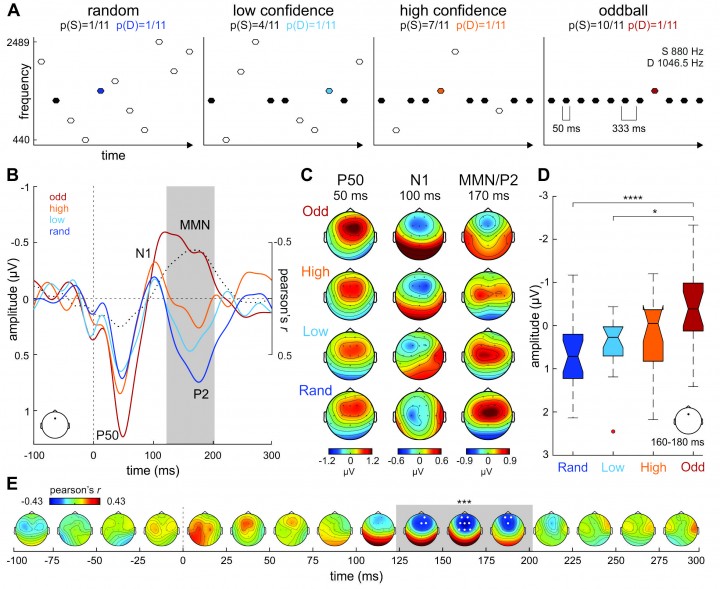The paper entitled Standard Tone Stability as a Manipulation of Precisions in the Oddball Paradigm: Modulation of Predicion Error Responses to Fixed-Probability Deviants by SanMiguel, I.; Costa-Faidella, J.; Lugo, Z.R.; Vilella, E. and Escera, C. has been published in Frontiers in Human Neuroscience.
This paper is the outcome of a collaboration between the Brainlab and the Institut d’Investigació Sanitària Pere Virgili (IISPV) where we investigated the effects of precision on sensory deviance detection signals.
Our brains have the difficult task of perceiving the world based on noisy sensory signals processed by a noisy biological system. Current models of brain function propose that in order to cope with these uncertainties, the brain has the double task of interpreting the sensory signals and estimating the level of noise, to keep track of how likely it is that the interpretations are correct. These secondary estimations appear critical for perception and learning, and may be specifically disrupted in certain psychiatric disorders. However, to date it is not clear how to obtain an objective measure of this neural process. Here, we show that one of the most widely used electrophysiological indices of brain function, the mismatch negativity (MMN), is graded by the variability of the sensory input, thus providing a direct measure of the brain’s estimation of the level of sensory uncertainty.

The full abstract reads as follows:
Electrophysiological sensory deviance detection signals, such as the mismatch negativity (MMN), have been interpreted from the predictive coding framework as manifestations of prediction error (PE). From a frequentist perspective of the classic oddball paradigm, deviant stimuli are unexpected because of their low probability. However, the amount of PE elicited by a stimulus can be dissociated from its probability of occurrence: when the observer cannot make confident predictions, any event holds little surprise value, no matter how improbable. Here we tested the hypothesis that the magnitude of the neural response elicited to an improbable sound (D) would scale with the precision of the prediction derived from the repetition of another sound (S), by manipulating repetition stability. We recorded the Electroencephalogram (EEG) from 20 participants while passively listening to 4 types of isochronous pure tone sequences differing in the probability of the S tone (880 Hz) while holding constant the probability of the D tone [1,046 Hz; p(D) = 1/11]: Oddball [p(S) = 10/11]; High confidence (7/11); Low confidence (4/11); and Random (1/11). Tones of 9 different frequencies were equiprobably presented as fillers [p(S) C p(D) C p(F) = 1]. Using a mass-univariate non-parametric, cluster-based correlation analysis controlling for multiple comparisons, we found that the amplitude of the deviant-elicited ERP became more negative with increasing S probability, in a time-electrode window consistent with the MMN (ca. 120– 200 ms; frontal), suggesting that the strength of a PE elicited to an improbable event indeed increases with the precision of the predictive model.
Reference:
SanMiguel I, Costa-Faidella J, Lugo ZR, Vilella E and Escera C (2021) Standard Tone Stability as a Manipulation of Precision in the Oddball Paradigm: Modulation of Prediction Error Responses to Fixed-Probability Deviants. Front. Hum. Neurosci. 15: 734200.
Permanent doi: https://doi.org/10.3389/fnhum.2021.734200.

